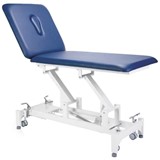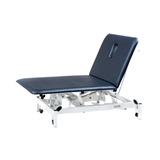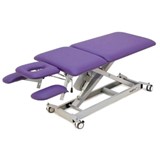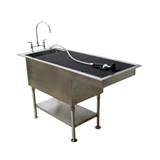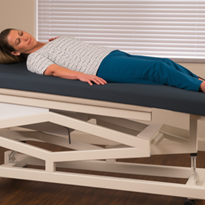A 2-section treatment table is an essential piece of equipment in healthcare and wellness practices. To ensure its longevity and performance, proper maintenance and care are crucial. Regular cleaning and diligent attention to the table's condition not only promote hygiene but also contribute to the safety and comfort of both patients and healthcare professionals. In this article, we will explore the best practices for maintaining and caring for your 2-section treatment table, ensuring that it remains in optimal condition for years to come.
Why Maintenance and Care are Important
Proper maintenance and care of your 2-section treatment table offer several key benefits:
- Hygiene and Sanitation: Regular cleaning prevents the buildup of dirt, sweat, or bacteria on the table's surface, promoting a clean and sanitary treatment environment.
- Longevity and Durability: Consistent maintenance helps extend the lifespan of the treatment table, ensuring that it continues to perform effectively over time.
- Patient Safety: A well-maintained table reduces the risk of accidents or injuries during treatments, keeping patients safe and secure.
- Professional Image: A clean and well-kept treatment table reflects positively on your practice, creating a favorable impression for patients and visitors.
Cleaning and Sanitizing the Table
Cleaning your 2-section treatment table regularly is essential to maintain a hygienic treatment environment. Here are some steps to follow for effective cleaning and sanitizing:
- Remove Debris: Start by removing any debris, such as dust or crumbs, from the table's surface.
- Use Mild Detergent: Mix a small amount of mild detergent with water to create a cleaning solution.
- Wipe Down the Surface: Use a soft cloth or sponge dampened with the cleaning solution to wipe down the table's surface thoroughly.
- Pay Attention to Joints and Crevices: Don't forget to clean the joints and crevices of the table, as these areas can accumulate dirt and grime.
- Rinse with Water: After cleaning, rinse the table's surface with clean water to remove any detergent residue.
- Disinfect Regularly: Periodically disinfect the table's surface using a suitable disinfectant to kill bacteria and viruses effectively.
- Dry Thoroughly: Ensure the table's surface is completely dry before using it for treatments.
Regular Inspection for Wear and Tear
Frequent inspections of your 2-section treatment table are essential to identify any signs of wear and tear. Here's what you should look out for:
- Check Moving Parts: Test the table's adjustable features, such as height adjustments and tilting mechanisms, to ensure they are functioning smoothly.
- Inspect Upholstery: Examine the upholstery for any signs of tears, fraying, or discoloration. Damaged upholstery should be repaired or replaced promptly.
- Stability and Levelness: Confirm that the table remains stable and level during adjustments. Uneven surfaces may indicate an issue with the table's structure.
- Check Bolts and Screws: Inspect and tighten any loose bolts or screws to maintain the table's stability and safety.
Preventive Maintenance
Implementing a preventive maintenance routine can help avoid major issues with your treatment table. Here are some preventive measures to consider:
- Follow Manufacturer's Guidelines: Adhere to the manufacturer's maintenance guidelines provided with the table to ensure you are caring for it correctly.
- Cover with Sheets or Towels: Using disposable or washable sheets or towels can protect the table's surface from excessive wear and bodily fluids.
- Avoid Harsh Chemicals: Use only approved cleaning products and avoid harsh chemicals that may damage the table's materials.
- Keep it Dry: Avoid spilling liquids on the table and promptly dry any spills to prevent damage.
- Store Properly: If the table is not in use, store it in a dry and clean environment, away from direct sunlight or extreme temperatures.
Cleaning and Sanitization Guidelines for a Hygienic Environment
Maintaining a hygienic environment is crucial for any setting, be it a healthcare facility, workplace, educational institution, or even our homes. Regular cleaning and proper sanitization not only promote a clean and pleasant space but also play a significant role in preventing the spread of infections and diseases. In this article, we will explore essential cleaning and sanitization guidelines to ensure a hygienic environment for everyone's well-being.
The Difference Between Cleaning and Sanitization
Before delving into the guidelines, it's important to understand the difference between cleaning and sanitization.
Cleaning involves the physical removal of dirt, dust, and debris from surfaces. This can be done using water, detergent, and mechanical action like scrubbing or wiping. Cleaning helps make surfaces visually clean and remove organic matter that can serve as a breeding ground for germs.
Sanitization, on the other hand, is the process of reducing the number of germs on surfaces to a safe level determined by public health standards. It involves using chemicals or heat to kill or neutralize bacteria, viruses, and other harmful microorganisms.
General Cleaning Guidelines
Regardless of the setting, the following general cleaning guidelines apply:
- Regular Cleaning Schedule: Establish a regular cleaning schedule based on the frequency of use and foot traffic in the area. High-traffic areas may require daily cleaning, while less frequented spaces can be cleaned on a weekly basis.
- Use Appropriate Cleaning Products: Select cleaning products suitable for the surfaces and materials being cleaned. Avoid using harsh chemicals on delicate surfaces.
- Proper Ventilation: Ensure proper ventilation during and after cleaning to allow fresh air to circulate and aid in drying surfaces.
- Cleaning Tools: Use clean and well-maintained cleaning tools such as mops, cloths, and brushes to avoid cross-contamination.
- Top to Bottom Cleaning: Start cleaning from the top (e.g., ceiling and upper shelves) and work your way down to avoid spreading dirt and dust onto previously cleaned areas.
Sanitization Guidelines
Sanitization is especially important in areas where high-touch surfaces and items are present. Here are some sanitization guidelines to follow:
- Focus on High-Touch Surfaces: Pay special attention to high-touch surfaces such as doorknobs, light switches, handrails, shared electronics, and frequently used equipment.
- Use Disinfectants: Choose appropriate disinfectants that are effective against a wide range of microorganisms. Follow the manufacturer's instructions for proper usage and contact time.
- Allow Contact Time: Ensure that the disinfectant remains in contact with the surface for the recommended contact time to effectively kill germs.
- Electronics and Devices: Use approved disinfectants or wipes specifically designed for electronic devices to avoid damaging sensitive equipment.
- Personal Protective Equipment (PPE): When handling disinfectants, wear suitable PPE such as gloves and goggles to protect yourself from chemicals.
Special Considerations for Healthcare Facilities
In healthcare facilities, additional measures are essential to maintain a hygienic environment:
- Hand Hygiene: Encourage frequent handwashing for both staff and patients. Provide hand sanitizing stations throughout the facility.
- Isolation Rooms: Implement thorough cleaning and sanitization protocols for isolation rooms and areas with potentially infectious patients.
- Medical Equipment: Regularly clean and disinfect medical equipment, especially items that come into direct contact with patients.
- Linens and Fabrics: Handle soiled linens and fabrics with care, and use appropriate cleaning and sanitization methods to prevent cross-contamination.
- Waste Disposal: Properly dispose of medical waste and ensure that waste bins are regularly emptied and sanitized.
Upholstery Replacement: Ensuring Cleanliness and Freshness
Upholstery plays a significant role in the comfort and aesthetics of furniture, be it in homes, offices, or commercial spaces. Over time, upholstery can accumulate dirt, dust, stains, and odors, compromising its cleanliness and freshness. Regular cleaning and maintenance can extend the life of upholstery, but there comes a point when replacement becomes necessary to ensure a clean and fresh environment. In this article, we will explore the importance of upholstery replacement, signs that indicate it's time for a change, and how to choose the right replacement upholstery.
The Importance of Upholstery Replacement
Upholstery replacement is not just about aesthetics; it also impacts the overall cleanliness and hygiene of the space. Here's why upholstery replacement is important:
- Hygiene and Health: Over time, upholstery can harbor allergens, dust mites, and bacteria, which can lead to respiratory issues and allergic reactions. Replacing old and contaminated upholstery promotes a healthier indoor environment.
- Odor Elimination: Accumulated spills, pet dander, and other sources can create unpleasant odors in the upholstery. Replacing the upholstery can eliminate lingering smells, making the space fresher and more inviting.
- Aesthetics: Worn-out and stained upholstery can make furniture and spaces look aged and unkempt. Fresh upholstery enhances the aesthetics of the furniture and the overall ambiance of the room.
- Comfort and Support: As upholstery ages, it may lose its original shape and cushioning, leading to reduced comfort and support. New upholstery ensures that furniture remains comfortable and supportive.
Signs It's Time for Upholstery Replacement
Here are some common signs that indicate it's time to replace the upholstery:
- Stains and Spills: Stubborn stains that don't respond to cleaning treatments can make upholstery look unsightly.
- Tears and Rips: Extensive tears and rips compromise the integrity of the upholstery and detract from its appearance.
- Foul Odors: Lingering unpleasant odors that persist despite cleaning efforts may require upholstery replacement.
- Flattened Cushions: Upholstery with flattened cushions no longer provides adequate comfort and support.
- Fading and Discoloration: Sunlight and age can cause upholstery to fade and lose its original color.
- Worn-out Fabric: If the fabric is frayed, faded, or threadbare, it's time for replacement.
Choosing the Right Replacement Upholstery
When selecting replacement upholstery, consider the following factors:
- Material: Choose upholstery material that suits the furniture's style and usage. Common options include fabric, leather, vinyl, and microfiber.
- Durability: Opt for upholstery that is durable and resistant to wear and tear, especially in high-traffic areas.
- Comfort: Test the upholstery for comfort and tactile appeal to ensure a pleasant seating experience.
- Color and Pattern: Select colors and patterns that complement the room's decor and create a cohesive look.
- Cleaning and Maintenance: Consider the ease of cleaning and maintenance required for the chosen upholstery material.
- Budget: Set a budget for the upholstery replacement and explore options that fit within your price range.
Professional Upholstery Services
Seeking professional upholstery services ensures a seamless and high-quality replacement process. Professional upholsterers can:
- Assess the Furniture: Expert upholsterers will examine the furniture's condition and recommend suitable replacement options.
- Provide Fabric Samples: They can offer a wide range of fabric samples to choose from, allowing you to see and feel the materials before making a decision.
- Ensure Proper Fit: Professional upholsterers will ensure that the new upholstery fits the furniture perfectly, avoiding any creases or wrinkles.
- Quality Craftsmanship: With their expertise, professional upholsterers deliver quality craftsmanship, ensuring that the finished product is pristine and long-lasting.
Conclusion
Taking care of your 2-section treatment table is vital to maintain a clean and safe treatment environment for your patients. Regular cleaning, sanitizing, and inspections will not only extend the table's lifespan but also ensure the comfort and well-being of those who use it. By following these maintenance guidelines and implementing preventive measures, you can keep your treatment table in optimal condition and continue providing top-notch healthcare and wellness services to your patients.

.png)
